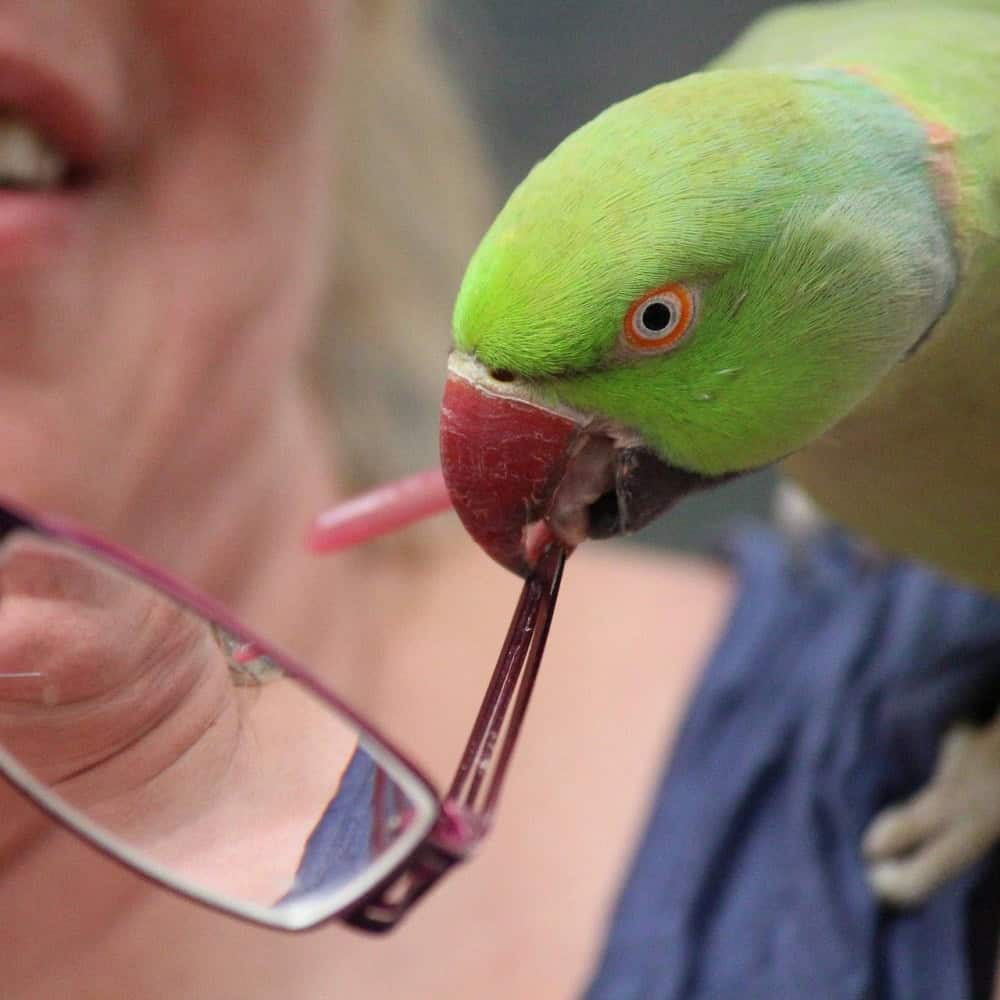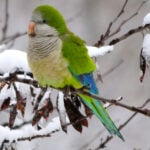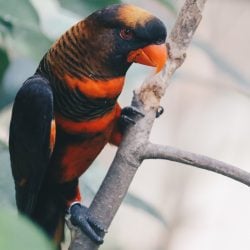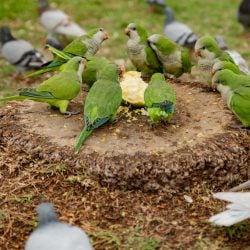
Which Higher Brain Regions Help Birds See Smartly?
Last Updated on by Mitch Rezman
Bird Brains and Vision: A Deeper Dive
- The Bird’s Eye View: Specialized Brain Regions
Birds possess remarkable visual capabilities, supported by four specialized brain regions, each playing a crucial role in visual processing and behavior:
- Entopallium (ENTO): This area functions as the bird’s object recognition center. It’s responsible for identifying shapes, colors, textures, and other visual features, essentially answering the question, “What am I seeing?” The Entopallium receives input from the eyes and other visual processing areas and uses this information to create a representation of the visual world.
- Visual Wulst: Acting as the bird’s spatial awareness center, the Visual Wulst tracks the movement and location of objects, answering the question, “Where is it?” It receives information about the position and motion of objects from the eyes and other visual areas and uses this information to create a dynamic map of the visual scene. The Visual Wulst is essential for navigation, flight control, and predator avoidance.
- Mesopallium Ventrolaterale (MVL): This region integrates information from the Entopallium and Visual Wulst, combining object recognition with spatial awareness. It allows the bird to create a comprehensive picture of its visual environment, enabling it to interact with objects and navigate its surroundings effectively.
- Nidopallium Caudolaterale (NCL): The NCL serves as the bird’s “executive center,” responsible for decision-making, planning, and memory. It uses visual information from other brain regions to guide behavior, such as deciding where to land, which food item to choose, or how to escape from a predator. The NCL is also involved in learning and memory, allowing birds to adapt their behavior based on experience.
- Left Brain, Right Eye: The Bird’s Visual Advantage
Studies have shown that birds, like chickens and pigeons, exhibit a visual preference for their right eye, which sends information to the left hemisphere of the brain. This left-brain dominance is believed to be linked to enhanced object recognition and rapid visual processing.
This asymmetry allows birds to quickly identify and react to potential threats or food sources in their environment. Additionally, the right eye and left brain are also specialized for controlling fine motor skills, such as pecking and grasping, which are essential for feeding and other behaviors.
- Object Recognition from All Angles
While we mammals possess a specific brain region called the inferior temporal cortex for recognizing objects from various viewpoints, birds achieve this feat through the NCL. The NCL acts as a central hub, integrating visual information and enabling birds to recognize objects even when they are upside down, partially hidden, or presented from different angles.
This ability is crucial for navigating complex environments and interacting with objects in a constantly changing world. Additionally, the NCL allows birds to recognize objects based on partial information, such as a glimpse of a predator’s tail or a partially obscured food item.
- Unraveling the Mysteries of Bird Vision: Research Focus Areas
Scientists employ various techniques to study the neural mechanisms underlying bird vision. Key areas of research include:
- Brain Connectivity: Investigating how different brain regions involved in vision are connected and how information flows between them. This research helps understand how visual information is processed and integrated to guide behavior. Advanced imaging techniques, such as fMRI (a neuroimaging technique that measures brain activity by detecting changes in blood oxygen levels) and diffusion tensor imaging (DTI a magnetic resonance imaging (MRI) technique that provides detailed information about the microstructure of white matter in the brain), are used to map the connections between brain regions and track the flow of information.
- Neurotransmitters: Examining the role of neurotransmitters, such as dopamine, in visual learning and memory. Dopamine is a key chemical messenger that reinforces rewarding behaviors and strengthens neural connections associated with visual experiences. Researchers use techniques such as microdialysis and optogenetics to manipulate neurotransmitter levels and study their effects on visual processing and behavior.
- Neural Activity: Measuring the electrical activity of brain cells in response to visual stimuli. This research provides insights into how different brain regions encode and process visual information. Techniques such as electrophysiology (the branch of physiology that pertains broadly to the flow of ions (ion current) in biological tissues and, in particular, to the electrical recording techniques that enable the measurement of this flow) and calcium imaging ( a microscopy technique that uses fluorescent molecules (calcium indicators) to optically measure calcium (Ca2+) levels in cells, tissues, or media, providing insights into cellular activity and function), are used to record the activity of individual neurons and populations of neurons in response to visual stimuli.
- Comparative Studies: Comparing the visual systems of different bird species to understand how vision has evolved to meet the specific needs of different ecological niches. This research provides insights into the diversity of visual adaptations in birds and the evolutionary pressures that have shaped them.
- Behavioral Studies: Observing and quantifying bird behavior in response to visual stimuli to understand how visual information is used to guide decision-making and action. This research provides insights into the ecological relevance of bird vision and the cognitive processes that underlie visual behavior.
- The NCL: The Bird’s Mission Control
The NCL plays a pivotal role in a bird’s cognitive processes, including:
- Decision-Making: The NCL evaluates visual information and other sensory inputs to make decisions about actions, such as choosing a food item or deciding whether to flee from a potential predator. The NCL integrates information about the potential rewards and risks associated with different actions and uses this information to make optimal choices.
- Reward-Based Learning: The NCL is involved in learning from positive and negative experiences. It associates visual cues with rewards or punishments, allowing birds to adapt their behavior and make informed choices. The NCL receives input from reward centers in the brain and uses this information to strengthen or weaken connections between visual stimuli and behavioral responses.
- Spatial Planning: The NCL uses visual information to plan routes and navigate through the environment. It enables birds to remember locations, anticipate obstacles, and find their way back to nests or food sources. The NCL creates a mental map of the environment and uses this map to plan and execute movements.
- Social Cognition: The NCL is also involved in social cognition, such as recognizing individuals, understanding social hierarchies, and communicating with other birds. The NCL processes visual information about the appearance and behavior of other birds and uses this information to guide social interactions.
Fun Fact: The remarkable capabilities of the NCL are exemplified by crows, which can distinguish between paintings by Picasso and Monet, showcasing their advanced visual discrimination and categorization abilities.
Conclusion
Bird brains have evolved specialized regions and sophisticated neural mechanisms to support their exceptional visual abilities. Ongoing research continues to unravel the complexities of bird vision and cognition, providing valuable insights into the evolution of the brain and the neural basis of behavior.
By studying bird vision, we can gain a deeper understanding of how the brain processes visual information, makes decisions, and guides behavior. This knowledge can be applied to a wide range of fields, including artificial intelligence, robotics, and neuroscience.
Written by Mitch Rezman and the Windy City Parrot content team
Author Profile
Latest entries
 The Traveling BirdJune 26, 2025Can You Name 5 Parrot Species That Are Living Wild in the USA?
The Traveling BirdJune 26, 2025Can You Name 5 Parrot Species That Are Living Wild in the USA? Bird BehaviorJune 26, 2025How is it Parrots Are Problem Solvers Social Animals and Even Use Tools?
Bird BehaviorJune 26, 2025How is it Parrots Are Problem Solvers Social Animals and Even Use Tools? Bird & Parrot AnatomyJune 25, 2025How a Tiny Chemical Modification Makes Parrots Nature’s Living Paintings
Bird & Parrot AnatomyJune 25, 2025How a Tiny Chemical Modification Makes Parrots Nature’s Living Paintings PigeonsJune 20, 2025How Do Parrots Thrive in Cities Outside Their Native Habitats?
PigeonsJune 20, 2025How Do Parrots Thrive in Cities Outside Their Native Habitats?



